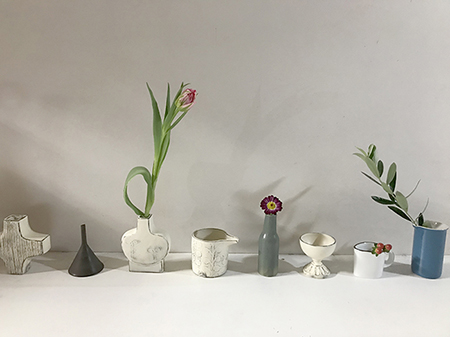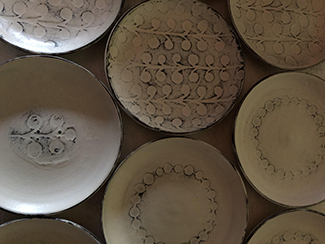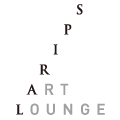Welcome to our ‘spiral market selection’ interview series, where we look at living from the viewpoint of artists and creators engaged in craftsmanship for daily life. For our first interview we talked with porcelain artist Tomomi Akahori and ceramic artist Atsushi Taira whose works featured together in the spiral market exhibition “point and line”.

──Inspiration flows at an atelier surrounded by nature
We moved to Shizuoka three years ago. With the ocean and Mount Fuji, we have nature right on our doorstep. There are all kinds of plants and something is always blooming or coming to fruit. Many different creatures gather here and lay their eggs… Putting myself in this place where I can truly feel the seasons – that has become the focal point for my creations.
I’m surrounded by sources of inspiration, so while I used to have to think in order to produce designs, they now flow to me naturally. That burden is gone. I am so happy to be able to create in such an environment. I am truly experiencing the shifting of the seasons first-hand.
Shapes and forms that I see in daily life sit in my memory for years, and suddenly one day, sometimes several years later, they burst forward as the inspiration for one of my creations. I also have a small child, and while that can be extremely challenging, raising my child is bringing energy to my creations. I didn’t notice it myself, but people say that they feel a warmth in my patterns since my child was born.

──The individual appeal of porcelain and ceramics
Because I create in the same space as Tomomi, I have a sense of the kind of works she is making. I suppose couples who are creators have quite an impact on each other, but I don’t know for sure in our case. I create ceramics and when I fire them I use plenty of oxygen using the technique “oxidation”.Tomomi ’s porcelain is the opposite – she limits oxygen to achieve a blue look with a technique called “reduction”. We use the same kiln but totally different approaches. But I suppose if you look at the big picture, we are influencing each other.
I find her perspective unique and fascinating. Her view of craftsmanship comes from picking up all the tiny points and elements that we might otherwise miss in our regular environment or in the routine of our daily life. Collecting the points creates a line – that’s the basis for her pieces. She discovers value in minute or subtle details and can combine those elements into a single piece through her truly unique perspective. When I look carefully at a piece it all makes sense, and I think “only she is capable of making a piece like this”. She might be drawn to some kind of scientific apparatus, for example. She gets inspiration from that but takes it one step further. She creates effects with unique glazes. She has the ability to choose really sweet and charming items – I’m always so impressed.
We chose the title for the exhibition – point and line – to reflect the image of her works. And also because I wanted to challenge myself to create work inspired by that theme.

──A study of Okinawan ceramics and the birth of an original technique
I love Okinawan folk songs and the attraction of that land led me to art university there. From a young age I enjoyed drawing and always thought I would study design, but it occurred to me that if I’m going to study in Okinawa I should choose something more deeply rooted in the native land. That’s how I came to ceramics. Folk craft is very strong in Okinawa and there are many teachers. When I actually touched the soil for the first time I found it fascinating and I was hooked on the three-dimensional nature of ceramics.
There’s a type of pottery in Okinawa called Tsuboya-yaki. It’s a style that developed in Okinawa because red soil is plentiful and white soil is more of a rarity. The technique involves firing something into a white piece of pottery with just a thin layer of white clay on the surface. My works incorporate a method in which a motif is created beneath that white clay layer. It’s my original technique but it’s really an extension of something I learned more than 20 years ago.
I also love antiques, especially ceramics from Korea, and I love visiting kilns in Korea. Their methods are different to mine, but I always like to soak up the passion they put into their pieces.

──The charm of a piece reveals itself through use
We use our own creations every day. We both like ceramics and enjoy visiting friends’ exhibitions and buying pieces that appeal to us. Using those pieces in our daily life, we find that they reveal different faces to us: they end up being easier to use than they look, or we find some new use for them. Our shelves are filled with pieces from all kinds of artists. Each day we let our moods choose pieces for us. Right now we are limited in which pieces we can incorporate into daily life for our child, who is still small, but we definitely want to use proper rice bowls once our child gets a little bigger.
Interview and editing by Spiral

1973 Born in Ichikawa City, Chiba Prefecture
1996 Graduated from Okinawa Prefectural University of Arts, Ceramics Course
1997 Apprenticed to Master Kiyoshi Hara
Born in Chiba, studied in Okinawa, trained in Saitama.
Currently engaged in ceramics-making in Shizuoka while gazing at Mt. Fuji.
Tomomi Akahori
1977 Born in Shizuoka Prefecture
2000 Completed studies at Kyoto College of Art (present-day Kyoto University of Art and Design)
2005 Completed work as studio artist at The Shigaraki Ceramic Cultural Park
Currently creating in Shizuoka
Instagram ID: akahoritomomi_
Inatagram ID:atsushi.taira

Venue:Spiral Market
※ The event has ended.





